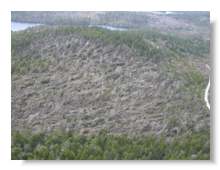
Basic Forest Fire Suppression Course - Online Lessons
LESSON 3 - EFFECTS OF WEATHER, TOPOGRAPHY AND FUELS ON FIRE BEHAVIOR
Fuel condition refers to stands of forest that have been altered by a natural event. An example of such an event would be: disease, insects, or weather phenomenon (hurricane, ice storm). Such events can occur over a long period of time (disease) and may affect fire behavior over the duration. A large insect infestation can have a devastating effect on a stand over a longer period of time and could impact fire behavior severely. In this case an entire stand will remain upright with considerable mortality. If this occurs, fire behaviour could become extremely aggressive and may resist all forms of suppression activity. In the case of a wind event (hurricane) fuels will be up rooted, broken, stacked on top of one another and can cause a situation that will make suppression activities difficult.
Be careful in any areas with such conditions, ground crews could be at risk.

Fuel moisture content limits fire propagation. When moisture content is high, fires are difficult to ignite, because more energy is required to complete the ignition process.
This property can be broken down into three segments:
- Moisture relationship (live and dead)
- Living plant moisture
- Foliar moisture content
Moisture relationships. Constant exchange of moisture between fuels and the ground as well as fuels and the atmosphere. This process is also mentioned in the Weather section (Relative Humidity).
Living plant moisture. Moisture content contained within a single plant during the period of a year. Plants will absorb moisture through their root system and depending on the time of the year and the amount of precipitation that has fallen will ensure that a plant is green or cured. Depending on the amount of moisture, a plant may contribute or resist combustion.
Foliar moisture content. Foliage (leaves and needles) moisture content will go through seasonal changes and the impact on fire behavior will depend on the time of year. In early spring, plants will begin to take in moisture which is added to the needles of softwood trees. At this point, hardwood trees do not have leaves which will allow more direct sunlight to warm up and dry out fine fuels on the surface. Fire behavior can be surprisingly aggressive during days with low relative humidity readings. During later spring conditions, new foliage in softwood trees will become evident as clusters of young needles wrapped in a covering that needs to be shed. Moisture is required from the tree in order for this to happen, and previous years foliage will divert some of its moisture to the new growth. At this point, burning conditions in softwood will be extremely intense because of the DIP in moisture content. This condition will most likely occur between mid May and early June. Be very cautious in softwood during this time period . Once needles have “flushed” (lost their outer covering) and moisture levels have returned to normal, fire behavior will return to expected conditions. Early summer will see a significant rise in moisture levels, and then a slow gradual decline as the year continues. Fire behaviour will react accordingly.
Some fuels have stored, volatile deposits of energy that are released on contact with heat. For that reason these species are more flammable than others without this characteristic. Resin and oils can be found in these species. The most commonly found in Nova Scotia is the pitch in the bark of White Birch as well as the resin in White Pine. Fire burning in these fuels can cause problems such as spark that is given off from White Pine (watch for sparks after dark).
This completes Lesson 3 - Effects of Weather, Topography, and Fuels on Fire Behavior